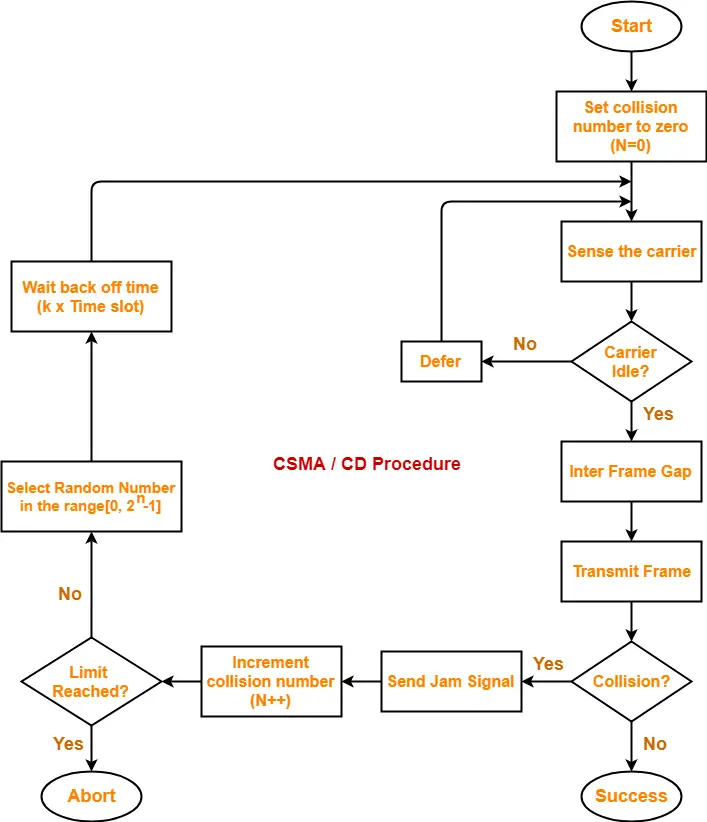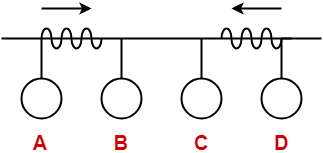CSMA / CD Protocol-
Before you go through this article, make sure that you have gone through the previous article on CSMA / CD Protocol.
We have discussed-
- CSMA / CD stands for Carrier Sense Multiple Access / Collision Detection.
- It allows the stations to sense the carrier and transmit data if the carrier is free.
The following CSMA / CD flowchart shows the CSMA / CD procedure-

Back Off Time-
In CSMA / CD protocol,
- After the occurrence of collision, station waits for some random back off time and then retransmits.
- This waiting time for which the station waits before retransmitting the data is called as back off time.
- Back Off Algorithm is used for calculating the back off time.
Back Off Algorithm-
After undergoing the collision,
- Transmitting station chooses a random number in the range [0, 2n-1] if the packet is undergoing collision for the nth time.
- If station chooses a number k, then-
| Back off time = k x Time slot |
where value of one time slot = 1 RTT
Example-
Consider the following scenario where stations A and D start transmitting their data simultaneously-

For simplicity,
- We consider the value of time slot = 1 unit.
- Thus, back off time = K units.
Scene-01: For 1st Data Packet Of Both Stations-
- Both the stations start transmitting their 1st data packet simultaneously.
- This leads to a collision.
- Clearly, the collision on both the packets is occurring for the 1st time.
- So, collision number for the 1st data packet of both the stations = 1.
At Station A-
After detecting the collision,
- Station A randomly chooses a number in the range [0, 21-1] = [0,1].
- If station A chooses the number KA, then back off time = KA units.
At Station D-
After detecting the collision,
- Station D randomly chooses a number in the range [0, 21-1] = [0,1].
- If station D chooses the number KD, then back off time = KD units.
Following 4 cases are possible-
| KA | KD | Remarks |
| 0 | 0 |
|
| 0 | 1 |
|
| 1 | 0 |
|
| 1 | 1 |
|
From here,
- Probability of station A to successfully retransmit its data after the 1st collision = 1 / 4
- Probability of station D to successfully retransmit its data after the 1st collision = 1 / 4
- Probability of occurrence of collision again after the 1st collision = 2 / 4 = 1 / 2
Now,
- Consider case-02 occurs.
- This causes station A to successfully retransmit its 1st packet after the 1st collision.
Scene-02: For 2nd Data Packet Of Station A And 1st Data Packet Of Station D-
Consider after some time,
- Station A starts transmitting its 2nd data packet and station D starts retransmitting its 1st data packet simultaneously.
- This leads to a collision.
At Station A-
- The 2nd data packet of station A undergoes collision for the 1st time.
- So, collision number for the 2nd data packet of station A = 1.
- Now, station A randomly chooses a number in the range [0, 21-1] = [0,1].
- If station A chooses the number KA, then back off time = KA units.
At Station D-
- The 1st data packet of station D undergoes collision for the 2nd time.
- So, collision number for the 1st data packet of station D = 2.
- Now, station D randomly chooses a number in the range [0, 22-1] = [0,3].
- If station D chooses the number KD, then back off time = KD units.
Following 8 cases are possible-
| KA | KD | Remarks |
| 0 | 0 |
|
| 0 | 1 |
|
| 0 | 2 |
|
| 0 | 3 |
|
| 1 | 0 |
|
| 1 | 1 |
|
| 1 | 2 |
|
| 1 | 3 |
|
From here,
- Probability of station A to successfully retransmit its data after the 2nd collision = 5 / 8
- Probability of station D to successfully retransmit its data after the 2nd collision = 1 / 8
- Probability of occurrence of collision again after the 2nd collision = 2 / 8 = 1 / 4
Now,
- Consider case-03 occurs.
- This causes station A to successfully retransmit its 2nd packet after the 2nd collision.
Scene-03: For 3rd Data Packet Of Station A And 1st Data Packet Of Station D-
Consider after some time,
- Station A starts transmitting its 3rd data packet and station D starts retransmitting its 1st data packet simultaneously.
- This leads to a collision.
At Station A-
- The 3rd data packet of station A undergoes collision for the 1st time.
- So, collision number for the 3rd data packet of station A = 1.
- Now, station A randomly chooses a number in the range [0, 21-1] = [0,1].
- If station A chooses the number KA, then back off time = KA unit.
At Station D-
- The 1st data packet of station D undergoes collision for the 3rd time.
- So, collision number for the 1st data packet of station D = 3.
- Now, station D randomly chooses a number in the range [0, 23-1] = [0,7].
- If station D chooses the number KD, then back off time = KD unit.
Following 16 cases are possible-
| KA | KD | Remarks |
| 0 | 0 |
|
| 0 | 1 |
|
| 0 | 2 |
|
| 0 | 3 |
|
| 0 | 4 |
|
| 0 | 5 |
|
| 0 | 6 |
|
| 0 | 7 |
|
| 1 | 0 |
|
| 1 | 1 |
|
| 1 | 2 |
|
| 1 | 3 |
|
| 1 | 4 |
|
| 1 | 5 |
|
| 1 | 6 |
|
| 1 | 7 |
|
From here,
- Probability of station A to successfully retransmit its data after the 3rd collision = 13 / 16
- Probability of station D to successfully retransmit its data after the 3rd collision = 1 / 16
- Probability of occurrence of collision again after the 3rd collision = 1 / 16
In the similar manner, the procedure continues.
Important Notes-
Note-01:
With each successive collision-
- Back off time increases exponentially.
- Collision probability decreases exponentially.
Note-02:
Back Off Algorithm is also known as Binary Exponential Back Off Algorithm because-
- It works for only two stations.
- The back off time increases exponentially.
- Collision probability decreases exponentially.
Note-03:
- One disadvantage of Back Off Algorithm is that it shows capture effect.
- It means if a particular station wins the collision one time, then its probability of winning the successive collisions increases exponentially.
To gain better understanding about Back Off Algorithm,
Next Article- Practice Problems On CSMA / CD & Back Off Algorithm
Get more notes and other study material of Computer Networks.
Watch video lectures by visiting our YouTube channel LearnVidFun.

